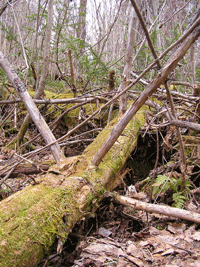Forest CSI: deadwood carbon in forests on opposite ends of the earth.Martin T. Moroni, Forestry Tasmania 
Biography : I grew up in Hobart, Tasmania, completing a Bachelor and PhD in the school of Agricultural Science at the University of Tasmania. Interest in forests commenced at the honours level examining nitrogen nutrition of Eucalyptus plantations, which continued into my PhD. After completing the PhD I sold my belongings and, with my new wife, bought a 1-way airfare to Vancouver in 2000. I wish someone told me Wayerhouser had just bought MacMillan Bloedel! With no work in Vancouver, I found work in Corner Brook Newfoundland with Natural Resources Canada. With NRCan my research on forest carbon commenced, leading me to deadwood. I studied deadwood in sub-arctic boreal Labrador, boreal Newfoundland and Acadian hardwoods in Nova Scotia, examining harvested, burned, insect killed, gap driven and old growth forests to fill holes in empirical knowledge and to evaluate forest C accounting tools. In 2009 I was offered a forest carbon research position in my home town of Hobart with Forestry Tasmania. Since my return to Tasmania, I have been compiling available knowledge on forest, which includes data on dead wood from over 4000 inventory plots. I grew up in Hobart, Tasmania, completing a Bachelor and PhD in the school of Agricultural Science at the University of Tasmania. Interest in forests commenced at the honours level examining nitrogen nutrition of Eucalyptus plantations, which continued into my PhD. After completing the PhD I sold my belongings and, with my new wife, bought a 1-way airfare to Vancouver in 2000. I wish someone told me Wayerhouser had just bought MacMillan Bloedel! With no work in Vancouver, I found work in Corner Brook Newfoundland with Natural Resources Canada. With NRCan my research on forest carbon commenced, leading me to deadwood. I studied deadwood in sub-arctic boreal Labrador, boreal Newfoundland and Acadian hardwoods in Nova Scotia, examining harvested, burned, insect killed, gap driven and old growth forests to fill holes in empirical knowledge and to evaluate forest C accounting tools. In 2009 I was offered a forest carbon research position in my home town of Hobart with Forestry Tasmania. Since my return to Tasmania, I have been compiling available knowledge on forest, which includes data on dead wood from over 4000 inventory plots.
Abstract :
Deadwood forms a dynamic and potentially substantial forest carbon pool. The significance of this pool to forest C stocks, and fluxes to and from it, are as variable as forests are themselves variable. In some forests dead wood is transient and forms a relatively large C pool for short periods. In other forests dead wood is a large, medium to long term forest C pool, where the maximum possible abundance of dead wood exceeds the maximum possible abundance of live wood.
Understanding dead wood carbon dynamics requires an understanding of how the dead wood came about: what sort of forest grew it and how did it die. Thus, the study of dead wood stocks and fluxes takes on characteristics of the occupation or TV show implied in the title.
The above will be illustrated in various forest types from opposite ends of the earth: Atlantic Canada and Tasmania. These locations encompass forests occupied by some of the largest, long lived trees that generate enormous quantities of persistent dead wood, to forests occupied by some of the smaller dimensioned production forest trees that generate short lived pulses of dead wood. These forests have contrasting ecologies and environments that have an interesting impact of dead wood abundances and cycles. Selected papers:
Newfoundland and Labrador
- Moroni, M.T., Shaw, C.H. and Otahal, P. 2010. Forest carbon stocks in Newfoundland boreal forests of harvest and natural disturbance origin I: Field study Canadian Journal of Forest Research 40: 2135-2145.
- Moroni, M.T., Shaw, C.H., Kurz, W.A., and Rampley, G.J. 2010. Forest carbon stocks in Newfoundland boreal forests of harvest and natural disturbance origin II Model evaluation. Canadian Journal of Forest Research 40: 2146-2163.
- Moroni, M.T., Hagemann, U. and Beilmann, D. 2010. Dead wood is buried and preserved in a Labrador boreal forest. Ecosystems 13: 452-458.
- Hagemann, U., Moroni, M.T., Gleissner, J, and Makeschin, F. 2010. Disturbance history influences downed woody debris and soil respiration. Forest Ecology and Management 260: 1762-1772.
- Hagemann, U., Moroni, M.T., Gleissner, J. and Makeschin, F. 2010. Accumulation and preservation of dead wood upon burial by bryophytes. Ecosystems 13: 600-611.
- Moroni, M.T. and Harris, D.D. 2010. Snag frequency, diameter and species distribution, and input rate in Newfoundland boreal forests. Forestry 83: 229-244.
- Hagemann, U., Moroni, M.T. and Makeschin, F. 2009. Dead wood abundance in Labrador high-boreal black spruce forests. Canadian Journal of Forest Research: 39: 131-142
Nova Scotia
- Moroni, M.T. and Ryan, D.A.J. 2010. Dead wood abundance in recently harvested and old Nova Scotia tolerant hardwood forests. Forestry 83: 219-227.
Tasmania
- Moroni, M.T., Kelley T.H. and McLarin, M.L. 2011. Carbon in trees in Tasmanian State forest. International Journal of Forestry Research. vol. 2010, Article ID 690462, 13 pages, 2010. doi:10.1155/2010/690462
|